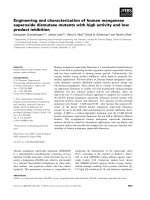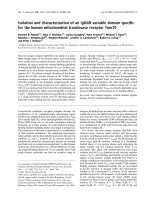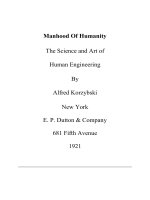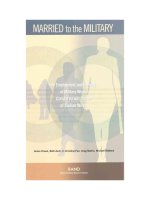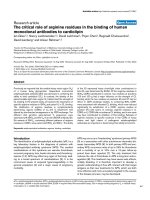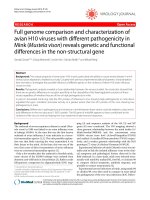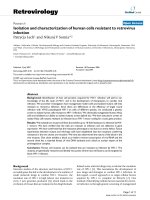GENERATION AND CHARACTERIZATION OF HUMAN MONOCLONAL ANTIBODIES WITH NEUTRALIZING ACTIVITY FOR DENGUE VIRUS
Bạn đang xem bản rút gọn của tài liệu. Xem và tải ngay bản đầy đủ của tài liệu tại đây (27.71 MB, 201 trang )
Generation and Characterization of
Human Monoclonal Antibodies with
Neutralizing Activity for Dengue Virus
En Wei Teo
B Eng (Hons), National University of Singapore
A thesis submitted for
the degree of Doctor of Philosophy
Department of Microbiology
National University of Singapore
2014
2
3
Acknowledgements
I would like to extend my heartfelt gratitude to my supervisor Associate Professor
Paul MacAry for giving me the opportunity to be part of his lab. Nothing would have
been possible if not for him believing in me and giving me the freedom to pursue
what I love doing. To Dr Brendon Hanson and his team – Angeline, Conrad, Annie
and Shyue Wei – thank you for the antibodies and advice. I am especially grateful for
Angeline for being ever so patient with teaching me molecular biology and Conrad
and Dominik for the initial generation of 10.15. To Dr Lok Shee-Mei, Petra and Jiaqi,
thank you for solving the cryo-EM structure of 14C10 and 10.15. To our collaborators
at NUH and TTSH, Dr Dale Fisher and Prof Leo Yee Sin, thank you for recruiting
patients for our study. To Prof Mary Ng and Boon, thank you for providing us with
technical advice and reagents. To Terence, thank you for your help with the live
imaging and being a great senior whom I could always go to for help. To A/Prof
Sylvie Alonso, for the expertise with all our in vivo work. Special thanks to Jowin for
teaching me how to work with mice despite his busy schedule.
To my mentor, Evelyn, thank you for introducing me to the world of dengue and
sharing everything you knew with me so generously. I miss having you as my partner
and friend in the lab. I attribute part of this thesis to her. To Lin Gen, my first mentor
in the lab when I first arrived to do my final year project, for teaching me all the
basics I needed in a life science laboratory. To the dengue team in PAM lab, Laura,
Emma, Gosia and She Yah for all the helpful discussions. To Voja and Sherlynn, for
learning how to generate the phage library at DSO with me. To Chien Tei, for being
more than a colleague but a friend who showered me with love all these years. To the
rest of the members of the PAM lab past and present – Adrian, Fatimah, Huda, Jun
Yun, Michelle, Olivia, Vicky, Weijian, Xilei, Yanting, Zhen Ying, thank you for
making my stay here such an enjoyable one. I am especially grateful to Emma,
Sherlynn and Yanting for proofreading the first draft of my thesis. To my attachment
students Carmen and Sheryl, for their help with the in vitro work for 10.15. To the
numerous friends I have made in Immunology Programme especially those who work
in the virus room, thank you for helping me in one way or another. To Lam, for all the
insightful intellectual discussions and for being a huge source of motivation.
4
To my Dad, for the bottles of celebratory champagne he got me, my mum for making
sure I did not have to worry about anything else at home and fetching me to and from
the lab almost all the time. To Qi, for being a wonderful sister and companion. To my
biggest fan Tim, for being my constant pillar of strength and believing in me more
than I believe in myself. And last but not least, to my grandma, who never saw the
end of this but would have been, I am certain, very proud of me. I dedicate this to her.
5
List of Publications
Ee Ping Teoh*, Petra Kukkaro*, En Wei Teo*, Angeline P. C. Lim, Tze Tong Tan,
Andy Yip, Wouter Schul, Myint Aung, Victor A. Kostyuchenko, Yee Sin Leo, Soh
Ha Chan, Kenneth G. C. Smith, Annie Hoi Yi Chan, Gang Zou, Eng Eong Ooi, D.
Michael Kemeny, Grace K. Tan, Jowin K. W. Ng, Mah Lee Ng, Sylvie Alonso, Dale
Fisher, Pei-Yong Shi, Brendon J. Hanson, Shee-Mei Lok,† Paul A. MacAry†. The
Structural Basis for Serotype-Specific Neutralization of Dengue Virus by a Human
Antibody. Science Translational Medicine. 2012 June 20;4(139):139ra83
*Co-First Author
Laura Rivino, Emmanuelle A. P. Kumaran, Vojislav Jovanovic, Karen Nadua,
En Wei Teo, Shyue Wei Pang, Guo Hui Teo, Victor Chih Hao Gan, David C. Lye,d,e
Yee Sin Leo, Brendon J. Hanson, Kenneth G. C. Smith, Antonio Bertoletti, David M.
Kemeny, and Paul A. MacAry. Differential targeting of viral components by CD4
+
versus CD8
+
T lymphocytes in dengue virus infection. Journal of Virology. March
2013; 87(5): 2693–2706.
List of Patents
Human Monoclonal Antibody with Specificity for Dengue Virus Serotype 1 E Protein
and Uses Thereof. Paul Anthony MacAry, Ee Ping Evelyn Teoh, Brendon John
Hanson, En Wei Teo, Angeline Pei Chiew Lim, Mah Lee Mary Ng, Shee Mei Lok,
Petra Eveliina Kukkaro. Publication Number: US 2013/0259871 A1. Publication
Date: October 3 2013.
A Fully Human Anti-Dengue Serotype 2 Antibody and Uses Thereof. Paul Anthony
MacAry, En Wei Teo, Shee Mei Lok, Wang Jiaqi, Brendon John Hanson, Conrad En
Zuo Chan. Invention Disclosure submitted October 2014.
6
Table of Contents
!! "#$%&'()$*&#+,,,,,,,,,,,,,,,,,,,,,,,,,,,,,,,,,,,,,,,,,,,,,,,,,,,,,,,,,,,,,,,,,,,,,,,,,,,,,,,,,,,,,,,,,,,,,,,,,,,,,,,,,,,,,,,+!-!
!,!! ./#0(/+1*%(2+,,,,,,,,,,,,,,,,,,,,,,,,,,,,,,,,,,,,,,,,,,,,,,,,,,,,,,,,,,,,,,,,,,,,,,,,,,,,,,,,,,,,,,,,,,,,,,,,,,,,,,,,,,,,,,,,,,,+!-!
"#"#"! $%&''()(*&+(,-!,)!./-01/!2(31'/'!#####################################################################################!"4!
"#"#5! 6('+,37!,)!./-01/!2(31'!######################################################################################################!5"!
"#"#8! $133/-+!9+&+1'!,)!+:/!9;3/&<!,)!./-01/!#######################################################################!5"!
"#"#=! >3&-'?(''(,-!&-<!*,13'/!,)!(-)/*+(,-!###########################################################################!55!
! 3&4/)(45%+6*&4&07+&8+.9:1+,,,,,,,,,,,,,,,,,,,,,,,,,,,,,,,,,,,,,,,,,,,,,,,,,,,,,,,,,,,,,,,,,,,,,,,,,,,,,,,,,,,,,,,,,,,,,,,+;<!
!,;+,,,,,,,,,,,,,,,,,,,,,,,,,,,,,,,,,,,,,,,,,,,,,,,,,,,,,,,,,,,,,,,,,,,,,,,,,,,,,,,,,,,,,,,,,,,,,,,,,,,,,,,,,,,,,,,,,,,,,,,,,,,,,,,,,,,,,,,,,,,,,,,,,,+;<!
! ./-01/!2(31'!@3,+/(-'!###################################################################################################################!5A!
"#5#"!#############################################################################################################################################################!5A!
"#5#"#"! $&;'(<!B$C!@3,+/(-!########################################################################################################################!5A!
"#5#"#5! @3/DE/?F3&-/!B;3EC!&-<!E/?F3&-/!BEC!@3,+/(-!########################################################!5G!
"#5#"#8! H-I/%,;/!BHC!@3,+/(-!###################################################################################################################!5G!
"#5#"#=! J,-D9+31*+13&%!@3,+/(-!"!BJ9"C!##############################################################################################!5K!
"#5#"#A! J,-D9+31*+13&%!@3,+/(-!5LM!5N!BJ95LM!J95NCM!=L!&-<!=N!BJ9=L!&-<!J9=NC!#####!5K!
"#5#"#G! J,-D9+31*+13&%!@3,+/(-!8!BJ98C!##############################################################################################!8O!
"#5#"#4! J,-D9+31*+13&%!@3,+/(-!A!BJ9AC!##############################################################################################!8O!
"#5#5! 9+31*+13/!,)!.HJ2!##################################################################################################################!8"!
"#5#8! P/;%(*&+(,-!*7*%/!,)!.HJ2!##################################################################################################!85!
"#5#8#"! P/*/;+,3!(-+/3&*+(,-!&-<!/-+37!##############################################################################################!85!
"#5#8#5! P/;%(*&+(,-!&-<!&''/?F%7!#########################################################################################################!88!
"#5#=! Q??1-,;& +:, 0/ -/ '('!,)!.H J 2 !########################################################################################!8=!
"#5#=#"! 61?,3&%!Q??1-/!P/';,-'/!&-<!L-+(F,<7!./;/-</-+!H-:&-*/?/-+!BL.HC!####!8A!
"#5#=#5! >:/!*/%%1%&3!(??1-/!3/';,-'/!###############################################################################################!84!
"#5#=#8! $7+,R(-/'!&-<!$:/?,R(-/'!######################################################################################################!8S!
"#5#=#=! $,?;%/?/-+!####################################################################################################################################!8K!
"#5#=#A! 2(31'!I(31%/-*/!###############################################################################################################################!8K!
"#5#=#G! 6,'+!0/-/+(*!)&*+,3'!#####################################################################################################################!=O!
"#5#A! @3/I/-+(,-!,)!./-01/!###########################################################################################################!=5!
"#5#A#"! 2/*+,3!$,-+3,%!################################################################################################################################!=5!
"#5#A#5! 2&**(-/'!1-</30,(-0!*%(-(*&%!/I&%1&+(,-!############################################################################!=8!
"#5#A#5#"! $:(?/3(*!2&**(-/'!###############################################################################################################!=8!
"#5#A#5#5! T(I/!L++/-1&+/<!2&**(-/'!################################################################################################!==!
"#5#A#5#8! 91F1-(+!2&**(-/'!#################################################################################################################!=A!
"#5#A#8! L-+(F,<(/'!&'!>:/3&;/1+(*'!######################################################################################################!=G!
7
"#5#A#8#"! L-+(F,<(/'!##############################################################################################################################!=G!
"#5#A#8#5! 9+3&+/0(/'!+,!U/-/3&+/!61?&-!L-+(F,<(/'!###############################################################!=S!
"#5#A#8#5#"! Q??, 3+&%(V& +(,- !,)!61 ? & -!N !$/%%'!#####################################################################!=K!
"#5#A#8#5#5! @:&0/!.(';%&7!>/*:-,%,07!#####################################################################################!A"!
"#5#A#8#5#8! 9(-0%/D$/%%!HW;3/''(,-!$%,-(-0!############################################################################!A5!
!,=! >#*?54+3&'/42+&8+.9:1+"#8/)$*&#+,,,,,,,,,,,,,,,,,,,,,,,,,,,,,,,,,,,,,,,,,,,,,,,,,,,,,,,,,,,,,,,,,,,,,,,,,,,,+<=!
"#8#"! J,-D61?&-!@3(?&+/'!BJ6@C!############################################################################################!A8!
"#8#5! E(*/!##############################################################################################################################################!A=!
"#8#5#"! X(%<D>7;/!BX>C!E(*/!#################################################################################################################!AA!
"#8#5#5! 9$Q.!E(*/!&-<!61?&-(V/<!E(*/!#############################################################################################!AA!
"#8#5#8! Q??1-,*,?; 3, ? ('/< !E (*/!#####################################################################################################!A4!
"#8#5#8#"! L+:7?(*!J1</!E(*/!############################################################################################################!A4!
"#8#5#8#5! LU"5K!E,1'/!E,</%!##########################################################################################################!AS!
;! @AB/)$*C/2+&8+$D*2+E%&B/)$+,,,,,,,,,,,,,,,,,,,,,,,,,,,,,,,,,,,,,,,,,,,,,,,,,,,,,,,,,,,,,,,,,,,,,,,,,,,,,,,,,,,,,,,+-!!
=! 35$/%*542+5#'+3/$D&'2+,,,,,,,,,,,,,,,,,,,,,,,,,,,,,,,,,,,,,,,,,,,,,,,,,,,,,,,,,,,,,,,,,,,,,,,,,,,,,,,,,,,,,,,,,,,+-;!
=,!! F/44+G*#/2+,,,,,,,,,,,,,,,,,,,,,,,,,,,,,,,,,,,,,,,,,,,,,,,,,,,,,,,,,,,,,,,,,,,,,,,,,,,,,,,,,,,,,,,,,,,,,,,,,,,,,,,,,,,,,,,,,,,,,,,,,,+-;!
=,;! 1*%(2+2$%5*#2+5#'+C*%(2+H%&H505$*&#+,,,,,,,,,,,,,,,,,,,,,,,,,,,,,,,,,,,,,,,,,,,,,,,,,,,,,,,,,,,,,,,,,,,,,,,+-=!
=,=! 1*%(2+I(5#$*8*)5$*&#+J+E45K(/+>2257+,,,,,,,,,,,,,,,,,,,,,,,,,,,,,,,,,,,,,,,,,,,,,,,,,,,,,,,,,,,,,,,,,,,,,,,+-L!
=,L! M7A%*'&?5+)(4$(%/+5#'+5#$*A&'7+H(%*8*)5$*&#+,,,,,,,,,,,,,,,,,,,,,,,,,,,,,,,,,,,,,,,,,,,,,,,,,,,,+-L!
=,<! E(%*8*)5$*&#+&8+.9:1+,,,,,,,,,,,,,,,,,,,,,,,,,,,,,,,,,,,,,,,,,,,,,,,,,,,,,,,,,,,,,,,,,,,,,,,,,,,,,,,,,,,,,,,,,,,,,,,,,,,,,+-L!
=,-! "2&45$*&#+&8+H% *? 5 %7 +F. ; ;
N
+)/442+,,,,,,,,,,,,,,,,,,,,,,,,,,,,,,,,,,,,,,,,,,,,,,,,,,,,,,,,,,,,,,,,,,,,,,,,,,,,,,+-<!
=,O! P/#/%5$*&#+&8+5#$*Q.9:1+5#$*A&'*/2+(2*#0+9H2$/*#Q65%%+C*%(2+R961S+Q
*??& %$5 4*T/ '+6 +)/442+,,,,,,,,,,,,,,,,,,,,,,,,,,,,,,,,,,,,,,,,,,,,,,,,,,,,,,,,,,,,,,,,,,,,,,,,,,,,,,,,,,,,,,,,,,,,,,,,,,,,,,,,,,,,,,,+-<!
=,U! P/#/%5$*&#+&8+5#$*Q.9:1;+5#$*A&'7+!V,!<+,,,,,,,,,,,,,,,,,,,,,,,,,,,,,,,,,,,,,,,,,,,,,,,,,,,,,,,,,,,+ !
8#S#"! $,-'+31*+(,-!,)!&!61?&-!Q??1-/!T(F3&37!#################################################################!GG!
8#S#5! @& (-0!,)!%(F3&37!&0&(-'+!.HJ25!##################################################################################!GG!
8#S#8! $,-I/3'(,-!,)!Y&F!+,!Q0U!&-<!HW;3/''(,-!,)!Q0U!#######################################################!G4!
=,W! 9#T7?/+G*#X/'+"??(#&2&%A/#$+>2257+R9G"Y>S+6*#'*#0+>2257+,,,,,,,,,,,,,,,,,,,,,+-O!
=,!V! E45K(/+Z/'()$*&#+:/($%54*25$*&#+[/2$+REZ:[S+:/($%54*25$*&#+>2257+,,,,,,,+-U!
=,!!! >#$*A&'7Q./H/#'/#$+9#D5#)/?/#$+R>.9S+>2257+,,,,,,,,,,,,,,,,,,,,,,,,,,,,,,,,,,,,,,,,,,,,+-W!
=,!;! E%/Q+5#'+E&2$Q5$$5)D?/#$+:/($%54*T5$*&#+>2257+,,,,,,,,,,,,,,,,,,,,,,,,,,,,,,,,,,,,,,,,,,,,,,+-W!
=,!=! "??(# & H% /) *H*$5 $*& #+H ( 44+'& \ #+,,,,,,,,,,,,,,,,,,,,,,,,,,,,,,,, ,,,,,,,,,,,,,,,,,,,,,,,,,,,,,,,,,,,,,,,,,,,+OV!
=,!L! .&$+64&$+,,,,,,,,,,,,,,,,,,,,,,,,,,,,,,,,,,,,,,,,,,,,,,,,,,,,,,,,,,,,,,,,,,,,,,,,,,,,,,,,,,,,,,,,,,,,,,,,,,,,,,,,,,,,,,,,,,,,,,,,,,,+OV!
=,!<! Y&'*(?+'&'/)74+J+H&475)%745?*'/+0/4+RY.YQE>P9S+5#'+]/2$/%#+64&$+,,,,,,+O!!
=,!-! [*?/QG5H2/+F&)54+G*C/+F/44+"?50*#0+,,,,,,,,,,,,,,,,,,,,,,,,,,,,,,,,,,,,,,,,,,,,,,,,,,,,,,,,,,,,,,,+O!!
=,!O! I(5#$*8*)5$*&#+&8+"#$%5)/44(45%+^4(&%/2)/#)/+,,,,,,,,,,,,,,,,,,,,,,,,,,,,,,,,,,,,,,,,,,,,,,,,,,,,+O;!
8
=,!U! F%7&Q/4/)$%&#+3*)%&2)&H7+RF%7&Q93S+,,,,,,,,,,,,,,,,,,,,,,,,,,,,,,,,,,,,,,,,,,,,,,,,,,,,,,,,,,,,,,,,,,+O;!
=,!W! In#Vivo+/_H/%*?/#$2+,,,,,,,,,,,,,,,,,,,,,,,,,,,,,,,,,,,,,,,,,,,,,,,,,,,,,,,,,,,,,,,,,,,,,,,,,,,,,,,,,,,,,,,,,,,,,,,,,,,+O=!
8#"K#"! Q-)/*+(,-!,)!E(*/!##################################################################################################################!48!
8#"K#5! 2(31'!Z1&-+()(*&+(,-!,)!@%&'?&!,)!Q-)/*+/<!E(*/!####################################################!48!
8#"K#8! 2(31'!Z1&-+()(*&+(,-!,)!+(''1/'!,)!Q-)/*+/<!E(*/!#####################################################!4=!
=,;V! Y$5$*2$*)54+>#5472*2+,,,,,,,,,,,,,,,,,,,,,,,,,,,,,,,,,,,,,,,,,,,,,,,,,,,,,,,,,,,,,,,,,,,,,,,,,,,,,,,,,,,,,,,,,,,,,,,,,,,,,,+OL!
L! Z/2(4$2+FD5H$/%+@#/+Q+>#$*Q.9:1!+>#$*A&'7+!LF!V+,,,,,,,,,,,,,,,,,,,,,,,,,,,,,,,,,,,,,+O<!
L,!! 6*#'*#0+5)$*C*$7+&8+!LF!V+*#+)&?H5%*2&#+$&+D(?5#*T/'+LP;+RD(LP;S+,,,,,,,,+O-!
L,;! :/($%54*T*#0+5)$*C*$7+&8+!LF!V+&#+<+0/#&$7H/2+&8+.9:1!+,,,,,,,,,,,,,,,,,,,,,,,,,,,,,,,,+OU!
L,=! >#$*A&'7+./H/#'/#$+9#D5#)/?/#$+R>.9S+&8+!LF!V+,,,,,,,,,,,,,,,,,,,,,,,,,,,,,,,,,,,,,,,,,+OW!
=#8#"! L.H!/))/*+!,)!I&3(,1'!'1F*%&''/'!,)!"=$"O!##################################################################!4K!
=#8#5! H))/*+!,)!Y*γ!3/*/;+,3!F(-<(-0!,-!L.H!########################################################################!SO!
L,L! F%7&/4/)$%&#+3*)%&2)&H7+R)%7&93S+2$%()$(%/+&8+!LF!V+^5AQ.9:1!+
F&?H4/_+,,,,,,,,,,,,,,,,,,,,,,,,,,,,,,,,,,,,,,,,,,,,,,,,,,,,,,,,,,,,,,,,,,,,,,,,,,,,,,,,,,,,,,,,,,,,,,,,,,,,,,,,,,,,,,,,,,,,,,,,,,,,,,,,,,,,,,,+U;!
L,<! E%/Q+C/%2(2+E&2$Q+>$$5)D?/#$+>2257+,,,,,,,,,,,,,,,,,,,,,,,,,,,,,,,,,,,,,,,,,,,,,,,,,,,,,,,,,,,,,,,,,,,,,,,+UU!
L,-! [*?/QG5H2/+F&)54+3*)%&2)&H7+,,,,,,,,,,,,,,,,,,,,,,,,,,,,,,,,,,,,,,,,,,,,,,,,,,,,,,,,,,,,,,,,,,,,,,,,,,,,+UW!
L,O! In#vivo+/88*)5)7+&8+!LF!V+,,,,,,,,,,,,,,,,,,,,,,,,,,,,,,,,,,,,,,,,,,,,,,,,,,,,,,,,,,,,,,,,,,,,,,,,,,,,,,,,,,,,,,,,,,,,,,+W<!
=#4#"! 91F*1+&-/,1'!B'#*#C!(-)/*+(,-!,)!H6Q!.HJ2"!BH6Q#."C!###########################################!KA!
=#4#5! Q-+3&;/3(+,-/&%!B(#;#C!(-)/*+(,- !,)!X/'+;&*4= !. H J 2 "!############################################!K4!
<! Z/2(4$2+FD5H$/%+[\&+Q+>#$*Q.9:1;+>#$*A&'*/2+,,,,,,,,,,,,,,,,,,,,,,,,,,,,,,,,,,,,,,,,,,,,,,+WW!
<,!! 6*#'*#0+5)$*C*$7+&8+!V,!<`+!;,!O+5#'+!L,!W+,,,,,,,,,,,,,,,,,,,,,,,,,,,,,,,,,,,,,,,,,,,,,,,,,,,,,,,,+!VV!
<,;! :/($%54*T*#0+>)$*C*$7+&8+5#$*Q.9:1;+>#$*A&'*/2+,,,,,,,,,,,,,,,,,,,,,,,,,,,,,,,,,,,,,,,,,,,,,,+!V-!
<,=! :/($%54*T5$*&#+H%&8*4/+&8+!V,!<+\*$D+C5%*&(2+2$%5*#2+&8+.9:1;+,,,,,,,,,,,,,,,,,,+!VU!
<,L! F&?H5%*2&#+&8+:/($%54*T*#0+5)$*C*$7+&8+!V,!<+5$+Z[+C/%2(2+=OaF+,,,,,,,,,,,,,,,,+!!V!
<,<! E%/Q+5#'+H&2$Q5$$5)D?/#$+#/($%54*T5$*&#+522572+&8+5#$*Q.9:1;+5#$*A&'*/2
+ !!!!
<,-! "??(# & H% /) *H*$ 5$*& # +522 57 +\ *$D+! V ,!< `+!; ,!O +5# '+! L ,!W +,,,,,,,,,,,,,,,,,,,,,,,,,,,,+!!=!
<,O! F&?H5%*2&#+&8+A*#'*#0+5A*4*$7+&8+D(=M<+5#'+!V,!<+$&+H(%*8*/'+.9:1;+&#+5+
%/'()*#0+Y.YQE>P9+,,,,,,,,,,,,,,,,,,,,,,,,,,,,,,,,,,,,,,,,,,,,,,,,,,,,,,,,,,,,,,,,,,,,,,,,,,,,,,,,,,,,,,,,,,,,,,,,,,,,,,,,,,,,,,,+!!L!
A#4#"! N(-<(-0!,)!.HJ25!?LF'!+,!3/*,?F(-&-+!H.QQQ!######################################################!""A!
<,U! 6*#'*#0+&8+!V,!<`+!;,!O+5#'+!L,!W+$&+%/)&?A*#5#$+.9:1;+9."""+&#+9G"Y>
+ !!-!
<,W! In#vivo+/88*)5)7+&8+!V,!<+,,,,,,,,,,,,,,,,,,,,,,,,,,,,,,,,,,,,,,,,,,,,,,,,,,,,,,,,,,,,,,,,,,,,,,,,,,,,,,,,,,,,,,,,,,,,+!!O!
A#K#"! 913I(I&%!3&+/'!,)!"O#"AD+3/&+/<!LU"5K!######################################################################!""4!
A#K#5! 913I(I&%!3&+/'!,)!LU"5K!?(*/!+3/&+/<!LU"5K!?(*/!(-)/*+/<![(+:!E>A!.HJ25!############################!"5=!
A#K#G! L''/''?/-+!,)!/))/*+!,)!"O#"A!(-!&!-,-D%/+:&%!.HJ 2 5!(- )/* +(,- !?,</%!########!"5A!
A#K#4! L''/''?/-+!,)!I(3/?(&!;3,)(%/!;,'+D+3/&+?/-+!######################################################!"5G!
A#K#S! $,?;&3(',-!,)!+:/!/))/*+!,)!"O#"A![(+:!:186A!&-<!:1=U5!+3/&+?/-+!,-!
;%&'?&!I(3/?(&!####################################################################################################################################!"5S!
A#K#K! >(+3&+(,-!,)!"O#"A!in#vivo!##################################################################################################!"8O!
-! .*2)(22*&#+,,,,,,,,,,,,,,,,,,,,,,,,,,,,,,,,,,,,,,,,,,,,,,,,,,,,,,,,,,,,,,,,,,,,,,,,,,,,,,,,,,,,,,,,,,,,,,,,,,,,,,,,,,,,,,,,+!=;!
O! >HH/#'*_+,,,,,,,,,,,,,,,,,,,,,,,,,,,,,,,,,,,,,,,,,,,,,,,,,,,,,,,,,,,,,,,,,,,,,,,,,,,,,,,,,,,,,,,,,,,,,,,,,,,,,,,,,,,,,,,,,,+!<W!
O,!! F$%()$*&#+&8+M(?5#+"??(#/+G*A%5%7+8%&?+H(%*8*/'+6+)/442+,,,,,,,,,,,,,,,,,,+!<W!
O,;! [*?/QG5H2/+F&)54+3*)%&2)&H7+1*'/&+F4*H2+,,,,,,,,,,,,,,,,,,,,,,,,,,,,,,,,,,,,,,,,,,,,,,,,,,+!-U!
4#5#"! T(I/!(-)/*+(,-!,)!N6]!*/%%'![(+:!.HJ2"!(-!+:/!;3/'/-*/!,)!&-!(',+7;/!*,-+3,%!
&-+(F,<7!##################################################################################################################################################!"GS!
4#5#5! T(I/!(-)/*+(,-!,)!N6]!*/%%'![(+:!.HJ2"!(-!+:/!;3/'/-*/!,)!&-!:1=U5!#########!"GS!
4#5#8! T(I/!(-)/*+(,-!,)!N6]!*/%%'

